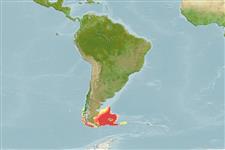Environment: milieu / climate zone / depth range / distribution range
Écologie
marin démersal. Deep-water; 44°S - 56°S
Southeast Pacific and Southwest Atlantic: Chilean and Argentine Patagonia.
Taille / Poids / Âge
Maturity: Lm ? range ? - ? cm
Max length : 31.9 cm SL mâle / non sexé; (Ref. 27363)
Description synthétique
Clés d'identification | Morphologie | Morphométrie
Épines dorsales (Total) : 0; Rayons mous dorsaux (Total) : 22 - 25; Épines anales: 0; Rayons mous anaux: 12 - 13. Pelvic fins small. Body pale brown with irregular dark blotches. Color variation recognized, from yellowish to dark brown (Ref. 27363).
Feeds mainly on benthic animals, polychaetes, small crustaceans, and mollusks (Ref. 27363).
Life cycle and mating behavior
Maturité | Reproduction | Frai | Œufs | Fécondité | Larves
Nakamura, I., T. Inada, M. Takeda and H. Hatanaka, 1986. Important fishes trawled off Patagonia. Japan Marine Fishery Resource Research Center, Tokyo. 369 p. (Ref. 27363)
Statut dans la liste rouge de l'IUCN (Ref. 130435: Version 2024-2)
Menace pour l'homme
Harmless
Utilisations par l'homme
Pêcheries:
Outils
Articles particuliers
Télécharger en XML
Sources Internet
Estimates based on models
Preferred temperature (Ref.
123201): 4 - 7, mean 5.7 °C (based on 155 cells).
Phylogenetic diversity index (Ref.
82804): PD
50 = 0.5005 [Uniqueness, from 0.5 = low to 2.0 = high].
Bayesian length-weight: a=0.00389 (0.00180 - 0.00842), b=3.12 (2.94 - 3.30), in cm total length, based on all LWR estimates for this body shape (Ref.
93245).
Niveau trophique (Ref.
69278): 3.4 ±0.41 se; based on food items.
Fishing Vulnerability (Ref.
59153): Low to moderate vulnerability (29 of 100).
Nutrients (Ref.
124155): Calcium = 38.7 [19.1, 87.7] mg/100g; Iron = 0.475 [0.233, 0.974] mg/100g; Protein = 15.6 [13.2, 17.8] %; Omega3 = 0.389 [0.153, 1.176] g/100g; Selenium = 23.7 [9.0, 60.1] μg/100g; VitaminA = 12.4 [2.6, 55.5] μg/100g; Zinc = 0.512 [0.330, 0.795] mg/100g (wet weight);
